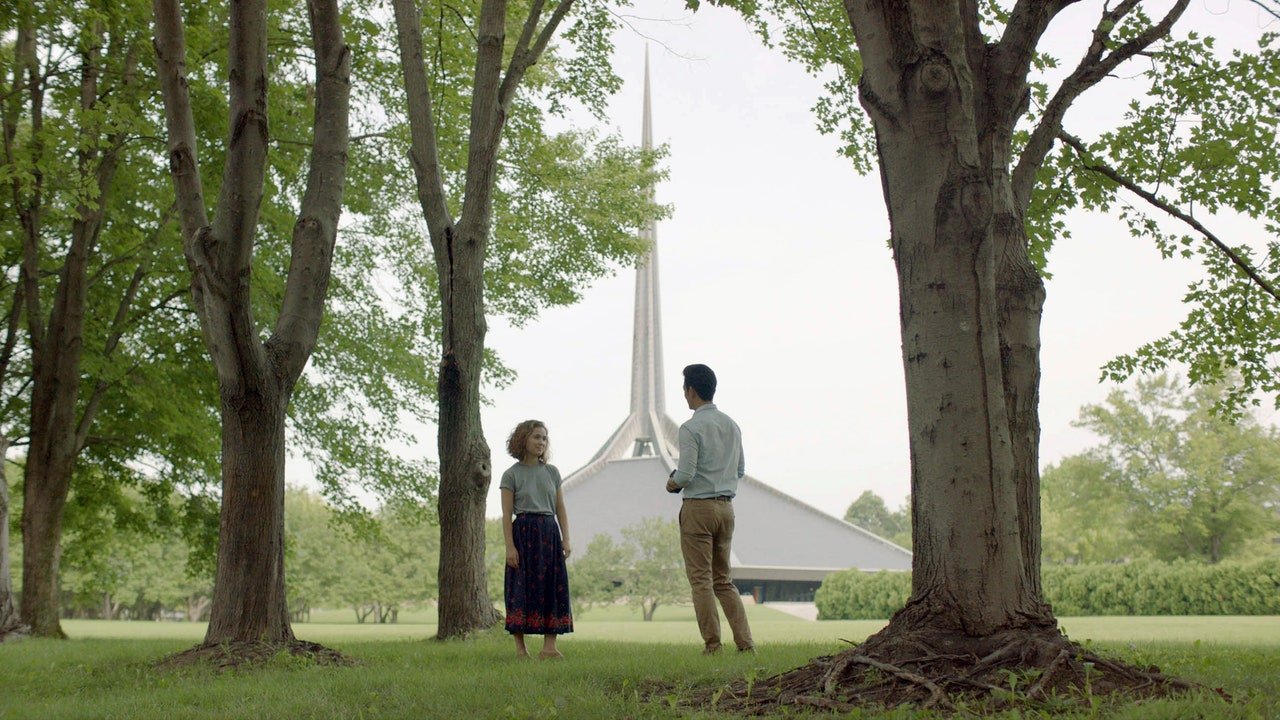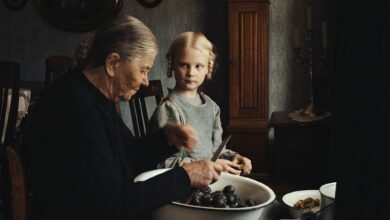
There’s a special kind of movie that’s inextricably linked to where it’s filmed. The locations aren’t just picturesque settings for action but part of the subject—as if the film were both a fictional drama and a documentary about the locale. One of the greatest such movies, “Columbus,” from 2017, directed by Kogonada, didn’t get the attention it deserved, but there are no excuses now that it’s streaming, and free, on Tubi. The title refers to the city of that name in Indiana, which has only about fifty thousand residents but is nonetheless a crucial center of modern architecture, thanks in large part to the passionate philanthropy of a local businessman, J. Irwin Miller, who, in 1954, established a foundation to commission and subsidize public buildings from prominent architects with advanced ideas, including Eero Saarinen, I. M. Pei, Robert Venturi, and Robert A. M. Stern. The Columbus cityscape is integral to the movie’s drama; all the more remarkably, it’s also at the heart of the movie’s style.
“Columbus” is a coming-of-age story—perhaps cinema’s only buildingsroman—centered on a young woman’s passionate connection to the city’s architectural treasures, and to architecture itself. Haley Lu Richardson plays Casey, who works shelving books in the public library (designed by I. M. Pei). Casey graduated from high school a year earlier; while friends have gone off to college, she has stayed home to care for her mother (Michelle Forbes), who is in recovery from substance abuse. Casey’s plan is to become one of the city’s architectural-tour guides; she knows a lot about its famed sights and cares deeply about them. But it’s a solitary passion until a visitor named Jin (John Cho) arrives from Korea. His father, from whom he is estranged, is a celebrated elderly architect who, while visiting Columbus, collapses and turns out to be gravely ill. Casey and Jin meet by chance, and, when she starts talking to him about the city’s architecture, he is platonically captivated by her intellectual discernment. Hoping to help the young woman change her life, he introduces her to a longtime friend, a professor named Eleanor (Parker Posey), who had been hosting his father.
From the very start of “Columbus,” Kogonada develops a comprehensively architectural cinema and does so in ways that feel integral to the characters’ experience; he brings the city’s great buildings to life by showing them in use. Eleanor strides through and around the sharp perpendicular lines and open perspectives of Eero Saarinen’s celebrated Miller House; Casey, rehearsing a tour guide’s spiel, paces near the concrete clock tower of First Christian Church, by Eero’s father, Eliel Saarinen; back in the library where she works, patrons wander amid theatre-like rows of low parallel shelves; she applies for a job in the glass-clad brightness of the Republic Newspaper Office, by Myron Goldsmith. Kogonada’s images—sometimes rectilinear and sometimes diagonal, sometimes distant and sometimes close, sometimes following people in motion and sometimes fixed—are as quietly rapturous as Casey’s gazes. They bring the buildings and the characters together with a sensibility that’s both graceful and precise. In one of the film’s most exquisite moments, Casey shows Jin, from the banal setting of her car, the building that sparked her aesthetic awakening; then her hand, holding a cigarette, traces the building’s outlines, as seen from her own ardently abstracting perspective.
With ordinary naturalistic means, “Columbus” displays a strikingly unified aesthetic; even elements of the film that aren’t physically dependent on the architecture of the city are suffused with it. The poise of the image-making, by the cinematographer Elisha Christian, adds the dimension of time to architecture. The images’ long durations fuse with the buildings’ cool serenity, making a bold visual statement about the self-consciously contemplative aesthetic of modernism itself. A crucial aspect of cinematic time is editing; Kogonada does his own in “Columbus,” making use of varied rhythms and surprising intercuts. He also wrote the screenplay, and his writing and editing together put me in mind of something I once heard the director James Gray say—that the narratives of feature films have a kind of architecture. Kogonada illuminates this idea in a way that mirrors the film’s subject. The film’s dramatic framework, for all its solidity, incarnates, in its ellipses and asymmetries, the shifting contemporary identities of revered civic masterworks.
Extended conversations in the shadow of the city’s mighty monuments seem tempered by their awe-inspiring power. The dialogue itself, epigrammatic and substantial, stylized and expressive, is consistent with Kogonada’s over-all approach. Scenes of long discussions seem brisk, even at pensive tempi, because of the way that the lines uttered strike off one another—and because of the energetically thoughtful performances that bring the characters to life. Though Casey’s aesthetic sensibility is ferocious, there’s also, initially, a callowness to it, an over-reliance on the historical and anecdotal formulas that she’s preparing to dispense as a tour guide. Jin, catching the fervor behind the formulas, coaxes her to speak from the heart about architecture—in a scene that emphasizes the momentous happenstance of their meeting.
When I wrote about “Columbus” at the time of its Sundance première, and then again, when it screened in New York, I emphasized its thoughtful and spirited performances, especially that of Richardson. As Casey, she cogently incarnates a young near-intellectual whose inchoate and pent-up powers seep out scathingly until they emerge, quietly but forcefully, with the spontaneity and brazenness of her age. There’s time in her performance, too: a sense of wheels turning within, even when she’s not speaking, the glimmers of impulses unexpressed. Cho, as the perceptive and generous Jin, distracted from his own family troubles by the sudden flashes of Casey’s bright light, is wise and rejuvenated; disinterested admiration makes this man, who looks to be in his forties, nearly a teen-ager again. So says Eleanor, who embodies the movie’s reality principle, not only handling the logistics of the ailing architect’s hospital stay and of Jin’s visit but also stage-managing, with unseen but adroit string-pulling, Casey’s new future.
If the mark of a movie’s art is its staying power—its resurgence in memory long after a viewing—then “Columbus” is a classic, for the frequency with which the tones and moods of its performances and images come to mind. From the movie’s engaging story to its very texture, Kogonada has crafted a singular and startlingly original cinematic vision—and I find that vision to be something of a conundrum. “Columbus” is his first feature, yet it seems to be a work of ripe and long-pondered experience, a film of youth that’s seen from beyond youth. It’s not revolutionary in the way that “Citizen Kane” is, but it shares with Orson Welles’s first feature the feeling of age, of starting late; there is more sense here of an ending, at least of one chapter, than of the beginning of another. I think of “Columbus” as the closing of a door that quickly follows its opening. Kogonada’s second film, the achingly melancholy science-fiction drama “After Yang” set in a dystopian future, doesn’t share the documentary methods or sensibility of “Columbus.” Perhaps the sense of civic virtue on which “Columbus” depends is, itself, a story of bygone times, and of mores that are, unfortunately, obsolete—essentially, a past-tense fantasy in counterpoint to a dystopian present day. ♦
Source link







